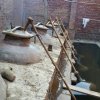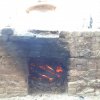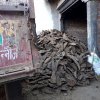The secrets of Indian oud.
- Thread starter Adam
- Start date
Part 1.
Traditional Indian distillation taking place in a closed system. Amazingly there is no way to release the pressure. Only skilful workers can keep the distillation running with out an explosion taking place. Simply by looking, touching and hearing the sound of a boiler they maintain the right gentle temperature so the pressure inside is not too high.
Simply amazing skills that give the best results.
However, there is no room for crazy temperature ups and downs that we at Feel Oud sometimes like to implement to give our oils an acrobatic touch...
We not say that any particular way is better or any particular style is the BEST. Never. It
is all about learning, sharing and appeciating
what others do as long as they infuse their oils with love and care!
Stay tuned for part 2.
Traditional Indian distillation taking place in a closed system. Amazingly there is no way to release the pressure. Only skilful workers can keep the distillation running with out an explosion taking place. Simply by looking, touching and hearing the sound of a boiler they maintain the right gentle temperature so the pressure inside is not too high.
Simply amazing skills that give the best results.
However, there is no room for crazy temperature ups and downs that we at Feel Oud sometimes like to implement to give our oils an acrobatic touch...
We not say that any particular way is better or any particular style is the BEST. Never. It
is all about learning, sharing and appeciating
what others do as long as they infuse their oils with love and care!
Stay tuned for part 2.
Part 2. The ultimate fuel.
Many people believe that in India fire wood is used as a fuel. It makes it extremely hard to control temperature, moreover it brings an additional smoky or even burned notes in to an oil. However, in most cases it is not true.
The ultimate fuel in India is... cow's dung. Oh yes you heard it right. One of the hidden truths about famous oud Hindi is the fact that it has been cooked using cow's dung for centuries. Surprisingly this unique fuel has absolutely no smell. It got pressed in to pallets and dried under the sun untill the experts consider it to be ready for use. Durring this process the unpleasant aroma feeds away completely. We were standing next to a mountains made of it and there was absolutely zero unpleasant aroma. The first advantage is its cost. It's nearly free comparing to gas and fire wood. Second interesting point is that it burns very gently, smoothly and consistently. It enables distillers to maintain the right and very gentle temperature durring the distillation. It also is much easier to control then the fire wood. Trained for centuries workers able to tell the thickness of those dung pallets by simply looking at them and they know exactly which pieces have to be used to achieve the desire temperature and an effect that they need.
Simply stunning! However, Feel Oud production is so tiny that we prefer to use gass as a fuel for our distillations. Perhaps one day we may implement this unique method
Many people believe that in India fire wood is used as a fuel. It makes it extremely hard to control temperature, moreover it brings an additional smoky or even burned notes in to an oil. However, in most cases it is not true.
The ultimate fuel in India is... cow's dung. Oh yes you heard it right. One of the hidden truths about famous oud Hindi is the fact that it has been cooked using cow's dung for centuries. Surprisingly this unique fuel has absolutely no smell. It got pressed in to pallets and dried under the sun untill the experts consider it to be ready for use. Durring this process the unpleasant aroma feeds away completely. We were standing next to a mountains made of it and there was absolutely zero unpleasant aroma. The first advantage is its cost. It's nearly free comparing to gas and fire wood. Second interesting point is that it burns very gently, smoothly and consistently. It enables distillers to maintain the right and very gentle temperature durring the distillation. It also is much easier to control then the fire wood. Trained for centuries workers able to tell the thickness of those dung pallets by simply looking at them and they know exactly which pieces have to be used to achieve the desire temperature and an effect that they need.
Simply stunning! However, Feel Oud production is so tiny that we prefer to use gass as a fuel for our distillations. Perhaps one day we may implement this unique method
Don't forget to check out vetiver cooked in those 'closed-system' setups. In my humble opinion, the higher quality Ruh Khus oils can rival (and even trump) some lower end oud oils.
Can't wait for your update from Assam (will you be heading there?). In Kannauj they still keep it traditional (well, at least some), so you get an idea of how OUD was also distilled in Assam a century ago. Please don't forget to share photos of how things are done in Assam.
In Kannauj they still keep it traditional (well, at least some), so you get an idea of how OUD was also distilled in Assam a century ago. Please don't forget to share photos of how things are done in Assam.
Can't wait for your update from Assam (will you be heading there?).
Oh yeh bro. After visiting few factiries and testing plenty of oils we got steam distilled vetiver (super smooth sweetness) as well as traditional copper hydro distilled (rounded depth and extended complexity) to be used in my future perfumes. Right... akin to our oil in some aspects, specialy the copper effect. It is definitely unique and of a very high quality. However, I won't dare to choose it over Indonesian varieties. There are so many.
Each serves the needs one may have...
As for Assam, no unfortunately. Next time perhaps.
Each serves the needs one may have...
As for Assam, no unfortunately. Next time perhaps.
Owwwh... 
Well maybe next time.
At any rate though, please share more about what you're witnessing in Kannauj. I have shared some of this info with others before, and have told them what it really means when one says (and I am one of them) that the Indian traditional distillers are THE unmatched masters of distillation. Instead of us holding onto a meaningless fanboy tantra, why don't you enlighten us so we all know what that really means.
Think about it.. I have had 3 explosions trying to replicate what they do, and of course I threw in the towel after the third time it happened, because it nearly took out my left eye and fried the left side of my face.
Whereas modern day distillation typically entails "distillers" loitering and napping and chatting on WhatsApp while a distillation is running, the way distillation was done in the good old days (and to this day in Kannauj, shrinking rapidly though sadly), a distiller does not have the luxury of being away from the pot. Its a non-stop live choreography, and to whoever doesn't know this (if you've seen me distill in person then you already know) it was these masters that inspired me to choreograph and be in control of every drop that trickles into the collector.
I will repeat: I threw in the towel. I could not do it. And I've done distillations with the pot just feet away from my bed (i.e. non-stop attention). So just imagine the skill those guys have.
What color is your traditional copper vetiver oil?
And by the way, its funny you mentioned Indonesian vetiver. I was having a chat with someone recently, and he said that Indonesian vetiver is the worst. I said NO, its only because in Indonesia the majority of vetiver is cooked with cost-efficiency being the priority. But if you smell raw Indonesian vetiver, or raw Brunei lemon grass, or raw Malaysian neelam (patchouli), you realize, there is nothing inferior about any of these (and other) natural aromatic substances. Its just that justice isn't done to them in most cases.
PS: those briquettes/pellets are called 'gobar', and for my grandmother back in her youth in her village (close to Meghalaya) it was the standard fuel. Families would make 'parathas' out of the dung and slap them on to the wall to dry. Once dried, these briquettes were the every day fuel for everything, including cooking food.
out of the dung and slap them on to the wall to dry. Once dried, these briquettes were the every day fuel for everything, including cooking food.
Lalitya and Lavanya were cooked with briquettes, in a restored vintage copper pot. Observe the color of those two. I'm willing to bet Chugoku Senkoh was distilled using briquettes too (in the same hue family).
Observe the color of those two. I'm willing to bet Chugoku Senkoh was distilled using briquettes too (in the same hue family).
Well maybe next time.
At any rate though, please share more about what you're witnessing in Kannauj. I have shared some of this info with others before, and have told them what it really means when one says (and I am one of them) that the Indian traditional distillers are THE unmatched masters of distillation. Instead of us holding onto a meaningless fanboy tantra, why don't you enlighten us so we all know what that really means.
Think about it.. I have had 3 explosions trying to replicate what they do, and of course I threw in the towel after the third time it happened, because it nearly took out my left eye and fried the left side of my face.
Whereas modern day distillation typically entails "distillers" loitering and napping and chatting on WhatsApp while a distillation is running, the way distillation was done in the good old days (and to this day in Kannauj, shrinking rapidly though sadly), a distiller does not have the luxury of being away from the pot. Its a non-stop live choreography, and to whoever doesn't know this (if you've seen me distill in person then you already know) it was these masters that inspired me to choreograph and be in control of every drop that trickles into the collector.
I will repeat: I threw in the towel. I could not do it. And I've done distillations with the pot just feet away from my bed (i.e. non-stop attention). So just imagine the skill those guys have.
What color is your traditional copper vetiver oil?
And by the way, its funny you mentioned Indonesian vetiver. I was having a chat with someone recently, and he said that Indonesian vetiver is the worst. I said NO, its only because in Indonesia the majority of vetiver is cooked with cost-efficiency being the priority. But if you smell raw Indonesian vetiver, or raw Brunei lemon grass, or raw Malaysian neelam (patchouli), you realize, there is nothing inferior about any of these (and other) natural aromatic substances. Its just that justice isn't done to them in most cases.
PS: those briquettes/pellets are called 'gobar', and for my grandmother back in her youth in her village (close to Meghalaya) it was the standard fuel. Families would make 'parathas'
Lalitya and Lavanya were cooked with briquettes, in a restored vintage copper pot.
Hydro/copper/old school distilled vetiver is deep dark green. The steam one is brown golden colour. Green one reminds me of our long soak Thai distillations (no maggots). Whereas the steam one has the Sabah, Borneo oud golden quality and smooth sweetness.
Indonesian vetiver is so diverse. Most common in the market is black burned stuff with the notes of rubber. However, if you know right people they can cook it nicely. Last time we came across vetiver absolute produced by one of the large companies there. I managed to grab 2010 batch. When I smelled it I knew exactly what I want to do with it. Soothing, resionous notes of chocolate, tobacco, dry earth, tonka bean like sweetness and depth akin to our Royal Bengali oud... so then Walimah perfume and attar were born.
Indonesian vetiver is so diverse. Most common in the market is black burned stuff with the notes of rubber. However, if you know right people they can cook it nicely. Last time we came across vetiver absolute produced by one of the large companies there. I managed to grab 2010 batch. When I smelled it I knew exactly what I want to do with it. Soothing, resionous notes of chocolate, tobacco, dry earth, tonka bean like sweetness and depth akin to our Royal Bengali oud... so then Walimah perfume and attar were born.



